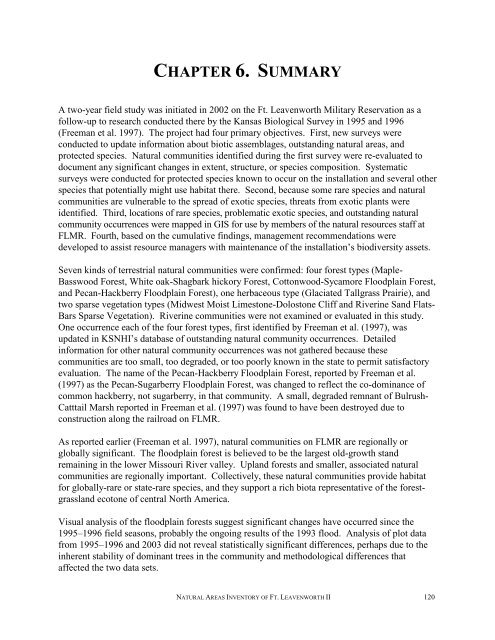A Natural Areas Inventory of the - Kansas Natural Heritage Inventory ...
A Natural Areas Inventory of the - Kansas Natural Heritage Inventory ...
A Natural Areas Inventory of the - Kansas Natural Heritage Inventory ...
Create successful ePaper yourself
Turn your PDF publications into a flip-book with our unique Google optimized e-Paper software.
CHAPTER 6. SUMMARY<br />
A two-year field study was initiated in 2002 on <strong>the</strong> Ft. Leavenworth Military Reservation as a<br />
follow-up to research conducted <strong>the</strong>re by <strong>the</strong> <strong>Kansas</strong> Biological Survey in 1995 and 1996<br />
(Freeman et al. 1997). The project had four primary objectives. First, new surveys were<br />
conducted to update information about biotic assemblages, outstanding natural areas, and<br />
protected species. <strong>Natural</strong> communities identified during <strong>the</strong> first survey were re-evaluated to<br />
document any significant changes in extent, structure, or species composition. Systematic<br />
surveys were conducted for protected species known to occur on <strong>the</strong> installation and several o<strong>the</strong>r<br />
species that potentially might use habitat <strong>the</strong>re. Second, because some rare species and natural<br />
communities are vulnerable to <strong>the</strong> spread <strong>of</strong> exotic species, threats from exotic plants were<br />
identified. Third, locations <strong>of</strong> rare species, problematic exotic species, and outstanding natural<br />
community occurrences were mapped in GIS for use by members <strong>of</strong> <strong>the</strong> natural resources staff at<br />
FLMR. Fourth, based on <strong>the</strong> cumulative findings, management recommendations were<br />
developed to assist resource managers with maintenance <strong>of</strong> <strong>the</strong> installation’s biodiversity assets.<br />
Seven kinds <strong>of</strong> terrestrial natural communities were confirmed: four forest types (Maple-<br />
Basswood Forest, White oak-Shagbark hickory Forest, Cottonwood-Sycamore Floodplain Forest,<br />
and Pecan-Hackberry Floodplain Forest), one herbaceous type (Glaciated Tallgrass Prairie), and<br />
two sparse vegetation types (Midwest Moist Limestone-Dolostone Cliff and Riverine Sand Flats-<br />
Bars Sparse Vegetation). Riverine communities were not examined or evaluated in this study.<br />
One occurrence each <strong>of</strong> <strong>the</strong> four forest types, first identified by Freeman et al. (1997), was<br />
updated in KSNHI’s database <strong>of</strong> outstanding natural community occurrences. Detailed<br />
information for o<strong>the</strong>r natural community occurrences was not ga<strong>the</strong>red because <strong>the</strong>se<br />
communities are too small, too degraded, or too poorly known in <strong>the</strong> state to permit satisfactory<br />
evaluation. The name <strong>of</strong> <strong>the</strong> Pecan-Hackberry Floodplain Forest, reported by Freeman et al.<br />
(1997) as <strong>the</strong> Pecan-Sugarberry Floodplain Forest, was changed to reflect <strong>the</strong> co-dominance <strong>of</strong><br />
common hackberry, not sugarberry, in that community. A small, degraded remnant <strong>of</strong> Bulrush-<br />
Catttail Marsh reported in Freeman et al. (1997) was found to have been destroyed due to<br />
construction along <strong>the</strong> railroad on FLMR.<br />
As reported earlier (Freeman et al. 1997), natural communities on FLMR are regionally or<br />
globally significant. The floodplain forest is believed to be <strong>the</strong> largest old-growth stand<br />
remaining in <strong>the</strong> lower Missouri River valley. Upland forests and smaller, associated natural<br />
communities are regionally important. Collectively, <strong>the</strong>se natural communities provide habitat<br />
for globally-rare or state-rare species, and <strong>the</strong>y support a rich biota representative <strong>of</strong> <strong>the</strong> forestgrassland<br />
ecotone <strong>of</strong> central North America.<br />
Visual analysis <strong>of</strong> <strong>the</strong> floodplain forests suggest significant changes have occurred since <strong>the</strong><br />
1995–1996 field seasons, probably <strong>the</strong> ongoing results <strong>of</strong> <strong>the</strong> 1993 flood. Analysis <strong>of</strong> plot data<br />
from 1995–1996 and 2003 did not reveal statistically significant differences, perhaps due to <strong>the</strong><br />
inherent stability <strong>of</strong> dominant trees in <strong>the</strong> community and methodological differences that<br />
affected <strong>the</strong> two data sets.<br />
NATURAL AREAS INVENTORY OF FT. LEAVENWORTH II 120


